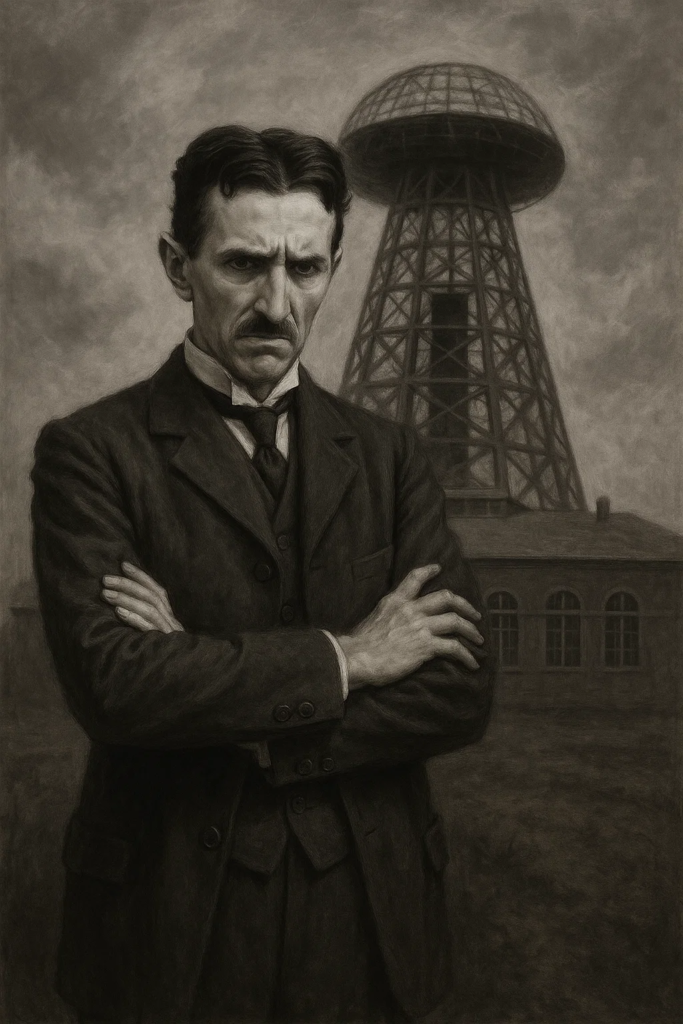In the early 20th century, in the town of Shoreham on Long Island, Nikola Tesla launched his most ambitious project: the Wardenclyffe Tower. It was an attempt to realize the idea of wireless transmission of energy and information around the globe—a key part of Tesla’s “World System,” which we covered in the previous post.
🌍 The Idea: A World Without Wires
Tesla envisioned a global system in which electrical energy could be transmitted through the Earth and the atmosphere—without losses and without cables. His theory of the planet as a resonant system was based on experiments he had conducted earlier in Colorado Springs. According to Tesla, the entire Earth could function as a resonant electrical conductor—if tuned to the right frequencies.
The tower was built between 1901 and 1902, standing 187 feet tall (about 57 meters), with an underground laboratory extending an additional 150–200 feet to access the Earth’s conductive layer. Tesla believed that full functionality would require a tower as tall as 600 feet, but he never secured the funding to achieve that.
💸 Finances, Morgan, and the Collapse
The project was initially financed by the powerful banker J.P. Morgan, who provided Tesla with $150,000—an enormous sum at the time. Morgan believed Tesla was working on a system that would improve wireless telegraphy, offering quick returns on investment. However, once he realized that Tesla’s real goal was free, wireless energy for the entire world—something with no clear business model or billing mechanism—he withdrew further support. In a widely quoted letter, Tesla wrote to Morgan:
“Can energy be charged for if it is transmitted freely everywhere? It cannot.”
That marked the beginning of the end for Wardenclyffe. Tesla tried to find new investors, but by then, his name had become associated with high risks and ideas far beyond the practical limits of the time. He fell into debt and was forced to mortgage the property.
⚡ What Was Achieved?
Documentation and testimony about the experiments are scarce, but there are claims that Tesla succeeded in lighting bulbs several miles away—without wires. On summer nights in 1903, some Long Island residents reportedly witnessed strange light phenomena, buzzing sounds, and atmospheric effects emanating from the tower. However, no experiment was ever confirmed as definitive proof of global-scale wireless power transmission.
In terms of communication, Tesla competed with Guglielmo Marconi, who in 1901 successfully transmitted a wireless signal across the Atlantic. Marconi used Tesla’s patents—without permission—which later led to a legal dispute. Still, investors shifted their attention to Marconi, whose approach was simpler and more profitable: Morse code, without energy.
🔥 The End of the Tower
With no money and no support, the project gradually faded. Tesla moved to New York and continued working from hotel rooms, increasingly poor and isolated.
In 1917, the tower was partially demolished to pay off some of Tesla’s debts. The equipment was sold, and the facility reportedly burned down during dismantling—though no official records of a fire exist. The site remained abandoned and nearly forgotten for decades.
🧠 A Vision Ahead of Its Time
Today, we know that many of Tesla’s ideas at Wardenclyffe were premature—but not senseless. Modern experiments in wireless power transmission (such as those by MIT and NASA’s solar satellite projects) partly confirm Tesla’s theories, though not on a global scale. His concept of the Earth as a resonant body is increasingly relevant in geophysics and electromagnetism.
The Wardenclyffe Tower never functioned as intended, but it became a symbol of unrestrained human vision.
Tesla never abandoned his beliefs, even when rejected by the business world and parts of the scientific community. The project cost him his finances, his public reputation, and perhaps his last chance to achieve the impact he had in his earlier years.
🏛️ The Final Echo
Today, the site of the tower is protected as part of the Tesla Science Center at Wardenclyffe. Thanks to a 2012 public campaign (supported by popular cartoonist Matthew Inman—The Oatmeal), funds were raised to purchase the location and build a museum.
In the next installment of the series, on MilovanInnovation, we’ll explore another area where Tesla was a pioneer—the use of high-frequency currents for medical and therapeutic purposes.


Leave a Reply